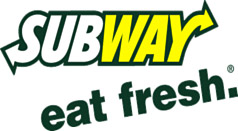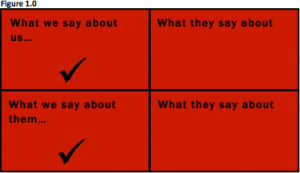There is little doubt, at this point, that the ability to effectively communicate ideas and carefully articulate concepts in a manner that is both persuasive and well received is nothing short of a highly sought-after art form. Businesses and individuals alike are frequently tasked with relaying salient and easily digestible information, but few individuals—short of politicians, feuding academics and out-of-touch celebrities—engage in heavily publicized competitive banter with an opposing stake holder. Businesses, on the contrary, often live and die by communication rooted in competition. The need for businesses to relay glowingly positive messages about their products and offerings while simultaneously and often subliminally disparaging their competitors is ever-present.
 Take for example Subway and their well-known slogan “eat fresh”. Are they really just saying something about their product? Or, perhaps while indicating that their product is always fresh, are they simultaneously relaying information indicating a lack of, or at least a lesser degree of, freshness at other fast-food establishments? By carefully crafting a messaging campaign or slogan businesses can reach, for all intents and purposes the perennial Shangri-La of advertising and communication, a message invoking a definitively positive sensation for the customer while, in contrast, invoking a negative emotion tied to the thought of the competing business or product.
Take for example Subway and their well-known slogan “eat fresh”. Are they really just saying something about their product? Or, perhaps while indicating that their product is always fresh, are they simultaneously relaying information indicating a lack of, or at least a lesser degree of, freshness at other fast-food establishments? By carefully crafting a messaging campaign or slogan businesses can reach, for all intents and purposes the perennial Shangri-La of advertising and communication, a message invoking a definitively positive sensation for the customer while, in contrast, invoking a negative emotion tied to the thought of the competing business or product.
This goal, however simple, is incredibly difficult to attain. This explains exactly why businesses all over the world allocate inordinate amounts of capital each and every year in pursuit of this goal. Often a major drawback found in many ineffective messaging campaigns, is allowing the competition to gain control of the message, and therefore control of the debate over which business and or product is preferable. When this happens organizations will often focus more of their attention on attacking their competitor, hoping to highlight the negative aspects of their offering. Unfortunately, this reactionary tactic generally does little more than exacerbate the problem. As Johnson Direct CEO and founder Grant Johnson often explains;
“Think of marketing or messaging like a conversation that you’re having with the customer at their dinner table.”
-Grant Johnson CEO, Johnson Direct
Now would it be an effective or, for that matter, appropriate strategy to inundate your host (the customer/client) with only negative reactions to statements or remarks about what a competitor or opponent has said about your product or business? Absolutely not! A much more effective strategy to employ would be continually highlighting those aspects or components of your business /product that will spark a potential customer interest while implying, without ever overtly stating, that those components of interest are exclusive to your offering and are therefore not possessed by the competition.
To begin making some positive in-roads toward gaining the upper hand in the battle for the “best in message” against your competitors, follow these steps and you will be well on your way to developing the air-tight message or slogan that can take your business to the next level:
- Create a message box (as shown in figure 1.0 below), complete with information regarding what you’re saying as well as information regarding what your competition is saying
- Continually refer back to the message box and ask yourself and your colleagues in which box is the public conversation taking place. If the answer is in either one of the boxes that contain a large checkmark, then congratulations! You’re controlling the message.
 More often than not, what is needed instead is a brand new message or slogan or a restructuring of how the message is being conveyed. While the development of a high-yield slogan or message can require a great deal of resources to master, any novice can amplify their marketing efforts through applying various tests to accurately measure if your efforts are working. The ability to utilize quality tests with appropriate sample sizes will undoubtedly give way to a greater return on investment. However, the process of applying measurable marketing can be difficult and, if skewed or executed incorrectly, the data captured can be ineffective. Therefore, if your business is attempting to internally develop sound data-driven marketing tests, be prepared to invest a great deal of time and money with little guarantee of success.
More often than not, what is needed instead is a brand new message or slogan or a restructuring of how the message is being conveyed. While the development of a high-yield slogan or message can require a great deal of resources to master, any novice can amplify their marketing efforts through applying various tests to accurately measure if your efforts are working. The ability to utilize quality tests with appropriate sample sizes will undoubtedly give way to a greater return on investment. However, the process of applying measurable marketing can be difficult and, if skewed or executed incorrectly, the data captured can be ineffective. Therefore, if your business is attempting to internally develop sound data-driven marketing tests, be prepared to invest a great deal of time and money with little guarantee of success.
On the other hand, another way to go about determining if your message is on-par is to contract with a full-service marketing agency like Johnson Direct, capable of creating quantifiable tests that will indicate in no uncertain terms whether or not your message is working—and if not, how to fix it. Partnering with a firm that boasts decades of experience and countless success stories will produce testing that can yield highly cost-effective, measurable, and actionable results.
For more information on how to measure your organizations marketing efforts visit: http://www.youtube.com/user/JohnsonDirect